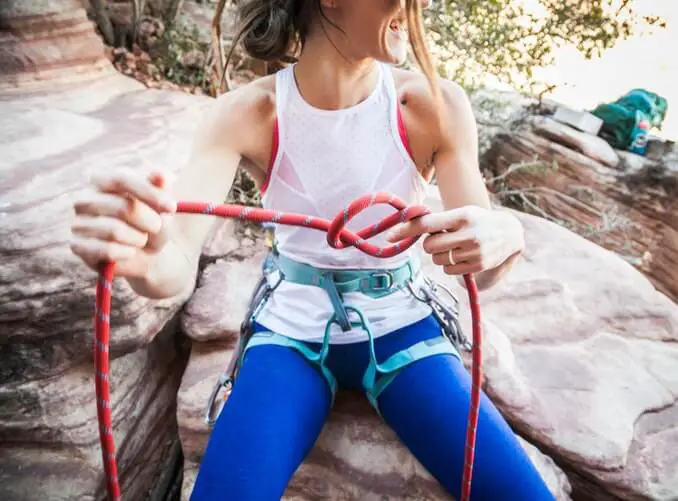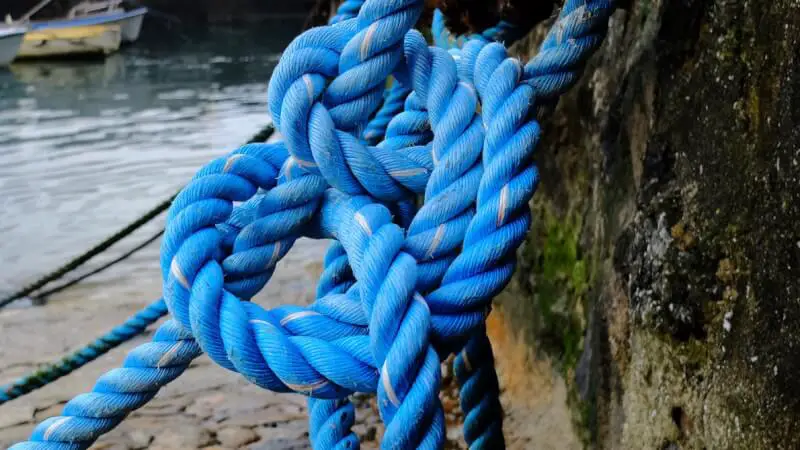The Most Important Knots for Rock Climbing
 The Most Important Knots for Rock Climbing
gearweare.net
The Most Important Knots for Rock Climbing
gearweare.net
Rock climbing is all about upward movement over vertical rock. Although this sport can feel incredibly scary and unnatural, when done correctly it is actually very safe. Safety is why the belay system has been devised and perfected over the years. This system is there to not only stop a climber from falling to the ground if they slip off the rock but also to ensure that the falls that they take are both soft and safe. Of course, the safety of a climb also depends on factors such as loose rock and how well protected the climb is as well, but for the purposes of this article we’re going to assume that the climbs one is getting on are not choosy and are well-bolted (or easily protectable with trad gear).
When it comes to properly setting up the system that you will use to safely climb, knots are critical. Like any activity that involves rigging with ropes, knowing the proper knots and how to tie them is life or death. A properly tied knot will work the vast majority of the time though, so climbers can concentrate on their movement and not on what will happen if they lose the send.
Although there are many knots that you will learn as you get deeper into climbing, there are only a few that are needed to first get into the sport. In this article, those knots will be presented first. These are the knots that one needs for gym climbing, and beginner sport and top roping outdoors. After that, an overview of some more advanced knots that every climber should have in their arsenal will be presented.
A final word about the knots used when rock climbing – A properly tied knot is literally your lifeline in this sport. Despite my five years I double check my own and my climbing partners’ knots every time one of us is ready to climb. There is even a famous story about the legendary Lynn Hill falling 85 feet from the top of a route because she had improperly tied her knot. She hit a tree and walked away, but she was lucky. With this in mind, don’t get cocky and always, ALWAYS remember to check your knot.
Table of Contents
Knot vs. Hitch vs. Bend
Although you will likely hear climbers refer to all of the methods for securing a rope outlined in this article as “knots”, in reality, they fall into three categories which they fall into.
Knot – A way to tie a piece of rope webbing that can hold its form without being secured to anything else.
Hitch – This is a way to secure rope to another object. If that object is removed the hitch will come undone.
Bend – A knot that is used to connect two separate ropes or pieces of webbing.
As stated earlier, whether something is a proper knot, a hitch, or a bend, you will likely hear climbers refer to it as a “knot”. For this reason, this article will also refer to all the different ways of tying rope and webbing outlined below as “knots”.
Knots That Every Climber Needs to Know
Directions for all the knots mentioned below can be found on the American Alpine Institute website and REI’s website.
Figure 8 Follow Through – If there is a knot to know when climbing it is this one. This is the knot every beginner is taught to use to secure the rope to their harness. It is ideal because it tightens when weighted. A Figure 8 Follow Through tied correctly is virtually impossible to untie.
The fact that this knot synchs when weighted becomes problematic when projecting since it can become quite difficult to untie. In fact, this knot has been known to become so tight it is “fused” and incredibly difficult to take off one’s harness.
Double Fisherman’s – This knot can be used to connect two ropes and create loops out of Cordelette, which can be used to set up top rope anchors. Like Figure 8 Follow Through, this knot gets tighter when weighted, and is therefore not ideal for tying ropes together for repels.
A Fisherman’s Knot (which is, unsurprisingly, one half of a Double Fisherman’s) is commonly used as a “back-up” knot on Figure 8 Follow Through. This is more to get the extra rope out of the way than for actually added safety.
Girth Hitch – This is an incredibly simple way to attach webbing or cord to an anchor point or your harness. The Girth Hitch is primarily used as a way to secure ready-to-go personal anchors to a climber’s harness.
European Death Knot – Despite its daunting name, this knot is a perfectly safe way to secure two ropes together. It is often used for rappelling since it flattens when weighted which means it is less likely to catch a rock.
Prusik – This knot is most often used as a back-up when rappelling. It easily slides up and down the rope when not weighted, however, will arrest a fall when weighted. It is actually a hitch, which is tied around the rope using Cordelette. The smaller the cord the tighter a Prusik knot will become when weighted.
Prusiks can be used to ascend a rope if one does not have an ascender. This is a useful knot that might not be used often at the sport crag, but every climber should have in their repertoire.
Munter Hitch – Although don’t ever want to have to use a Munter Hitch (it twists rope like crazy) this is an important knot to know. That’s because it can be used to repel or belay. If you mistakenly drop or forget your belay device, this knot could save your life.
Clove Hitch – This knot is an easy way to secure the rope to a carabiner. It is especially useful because it can be tied with one hand. Do exercise caution when using a Clove Hitch though, as they have been known to wiggle when weighted.
Other Knots That Climbers Should Learn
Here is a quick list of a few other important knots for climbers to know. Many of these become integral as one grows their skills in the mountains and are commonly used when multi-pitch climbing.
- Autoblock Knot
- Barrel Knot
- Bowline Knot
- Butterfly Knot
- Double Bowline Knot
- Figure 8 Bend
- Figure 8 on a Bight
- Klemheist Knot
- Overhand on a Bight
- Stopper Knot
- Water Knot














